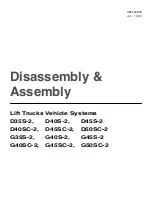
In this environment, the menus are highlighted by the steady light of both the “kg” and “lb” LEDs, and the keys take on the
following meanings:
- the “on/off” key changes its meaning to ‘
escape’ from the menu
- the“zero” key
changes its meaning to ‘confirm’ or access menu
- the“tare” key
changes its meaning to “minus” or backward scrolling.
- the ‘kg/lb’ key changes its meaning to
“plus” or forward scrolling.
The display then shows the following menu items, which you can scroll forward or backward with the
plus
or
minus
keys
(i.e. “kg/lb” and “tare”).
Use the
confirm (“zero”) key to access the selected menu.
Briefly press the
escape
(“on/off”) key to exit the menu. Important: if you hold down the “on/off” key for at least one second,
the instrument will be switched off.
These are the available menu items:
- “nCEL” configures the instrument to 3 or 4 cells
- “CALP” for initial calibration of zero and load
- “CALn” for fine calibration of individual cells (adjustment of angles)
- “CALF” for fine calibration of zero and load
When entering the weight calibration functions (CALP, CALn, CALF), the “kg”, “lb” and “BAT” LEDs are individually activated
to flash, in order to signal if the measured weight is centred with respect to the division displayed.
The “lb” LED indicates that the weight is centred with respect to the displayed division, the “BAT” LED indicates that the weight
is slightly lower than the central value of the division, and the “kg” LED indicates that it is slightly higher. Also in case that the
“lb” LED flashes alternating with the “kg” or “BAT” LEDs the weight is centred with respect to the displayed division.
This type of signalling is particularly useful when finely calibrating individual cells and the load (CALn and CALF).
Remember that, when fine-calibrating, the small corrections being made are more evident, the greater the test load used.
Selecting the number of cells (3 or 4)
When you enter the menu with the
confirm
(“zero”) key, the number of cells selected previously is shown. Use the
plus
and
minus
keys to change the selection. Next, confirm by means of the
confirm
key and the LCD display shows CALP.
Initial calibration of load
When performing this calibration, do not take into account the “kg”, “lb” and “BAT” LEDs.
This calibration is done when you first calibrate the instrument or when you wish to fully re-calibrate it.
This function resets all parameters obtained with every previous calibration.
To modify the existing calibration, use the fine calibration functions of the individual cells and of the load.
To enable this procedure, select menu item “CALP” and confirm with the “zero” key.
With the instrument unloaded, press the “zero” key and check if the display shows zero. Then place a known sample weight
on the load receiver, in a central position with respect to the 3 (or 4) cells, and press the “zero” key to temporarilysave the
measured value.
Before confirming with the “zero” key the display may not show an accurate weight value, but, instead, may indicate that
the load is above maximum capacity. Nevertheless, press the “zero” key to temporarily save this value.
The display shows the reference calibration value (initially set at 1000 kg for convenience), which you may then adjust with
the
kg/lb
and
tare
keys (in steps of 1, 10, 100 and 1000 kg) until you obtain the value of the previously used sample weight.
In this case, use the “kg/lb” key to increase the flashing figure, and the “tare” key
to select the figure you wish to modify.
When you confirm this value with the tasto “zero” (“zero” key), the instrument calculates the correction coefficients of all
the cells.
Finally, take off the load from the instrument, press the tasto “zero” (“zero” key) and check if the display shows zero value.
To exit this calibration, press the “on/off” key – the LCD display shows CALn.
Fine calibration of individual cells
Select menu item “CALn” and confirm with the “zero” key. The LCD display shows the value of the calculated weight.
With the instrument unloaded, press the “zero” key and make sure that the display shows zero value, then place a known
sample weight on the load receiver, in a central position with respect to the 3 (or 4) cells. We advise you to use weights of
1/5 to 1/10 of capacity. Next press the “tare” and “kg/lb” keys to increase or reduce the displayed value of the weight until
you obtain an indication of the value of the weight laid on the instrument.
Make the last, fine adjustments, observing LEDs “kg”, “lb, and “BAT”. The instrument is correctly calibrated when the “lb”
LED flashes.
Important: the
plus
and
minus
keys (“tare” and “kg/lb”) are used for small corrections. You may need to press the key
several times to ensure that the small corrections change the displayed value of the load.
Repeat this procedure, placing the load in line with each of the instrument’s cells, and change the displayed value until you
obtain the exact value of the load being used.
22
Summary of Contents for PX 20
Page 1: ......
Page 3: ...A B S4 1185 117 Z l 2...
Page 4: ...C D 3...
Page 5: ...F G 4...
Page 6: ...5...
Page 8: ...7...
Page 82: ......
















































